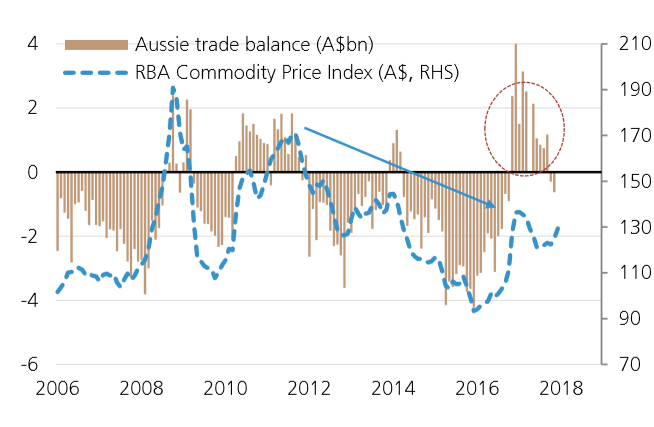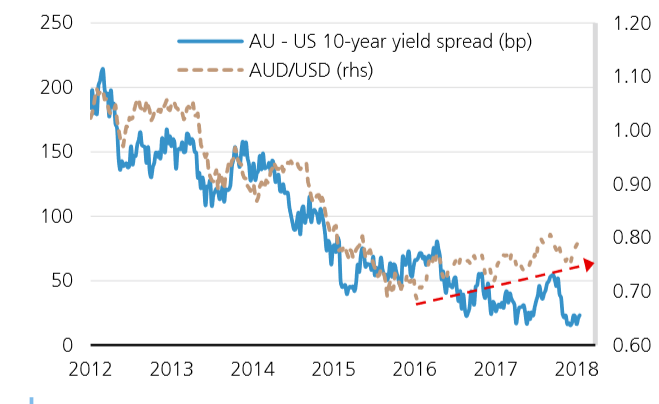Analysts Dual on Australian Dollar Outlook

We hear why forecasts for the Australian Dollar to decline in 2018 could be off the mark.
Swiss lender UBS have confirmed they see the current Australian Dollar uptrend continuing, having assessed that global commodity prices are likely to remain robust.
Commodities are an integral foreign currency earner for Australia and therefore a source of support for the AUD; higher prices clearly increase aggregate demand for the currency, thereby increasing its value.
Analysts at the Swiss-based banking giant see the uptrend in commodity prices continuing, but more crucially perhaps for the Australian Dollar, they also see a continued rise in the sheer volume of demand which will offset any weaknesses in price that may occur.
The Australian Dollar was seen under pressure earlier this week amidst a sharp fall in iron ore prices, confirming that the price of the commodity continues to play a key role in the currency's direction.
"The AUD has its worst day in more than a month as investors were caught long as iron ore prices collapsed by over 4.5% at one stage during the session," says Valentin Marinov, an analyst with Crédit Agricole.
Iron ore - Australia's largest foreign currency earner - saw prices slip to $64/tonne but some argue that the Aussie trade balance will nevertheless remain in surplus regardless of near-term price disruptions owing to the sheer volumes of iron ore Australia is able to ship. And this should provide support for the currency in 2018.
"The pick-up in global trade, is symbolised by record high iron ore export volumes from Australia's 'Big 4' mining companies in December 2017. Rising export volumes is not a new phenomenon, but rather part of a multi-year trend which explains why Australia's trade balance is likely to remain firmly in surplus over the coming year, despite materially weaker terms of trade than in 2011," says UBS Strategist Themos Theotakis.
The call comes in the same week that we reported Australian high-street banking giant Westpac were calling a 10% decline in the Australian Dollar in 2018; at a time the currency moves above the 0.80 level against the US Dollar.
The view is based on an expectation that the Dollar will recover in 2018 boosted by three 0.25% interest rate hikes at the US Federal Reserve while commodities are forecast to fall in price by circa 20.0% over the same time.

Above: Higher volumes of iron ore exports compensate for falls in prices, contributing to Australia's trade surplus. Image (C) UBS.
Westpac believe the US Dollar should stage a recovery in 2018 as the Federal Reserve raises interest rates, while the RBA is seen maintaining interest rates which should drive the differential in interest rates in favour of the US Dollar.
However, UBS suggest interest rates do not matter to the extent that they once did; "the increasing impact of cyclical influences on the AUD is also symbolised by how the currency has broken away from its past relationship vs. interest rates spreads."

Above: For the Australian Dollar, interest rates are no longer in the driving seat. (C) UBS.
Westpac think the Dollar could be bottoming out low after the recent sharp sell-off and be about to rebound, and this will lower commodity prices and contribute to the fall in AUD.
UBS on the other hand, do not expect the Dollar to recover as, according to their valuation models the currency is still about 8-10% overvalued on a PPP basis, which is the acronym for Purchasing Power Parity.
"Even after its decline this year, the dollar remains 10-15% overvalued on a PPP basis," says Theotakis.
PPP estimates a 'fair' value for a currency pair by simply comparing the cost of a basket of identical goods from the two currency jurisdictions - that then provides the PPP exchange rate.
Thus, for the sake of example, if an Aussie basket of goods costs A$10.0 and an 'identical' US basket costs US$9.0, then the PPP exchange rate is estimated at 0.90 for AUD/USD.
Given the current exchange rate is nearer 0.80, the conclusion is that the Aussie is undervalued against the Dollar and will probably rise up nearer to the PPP estimate.
In the real world these imbalances, however, can last for quite some time.
Get up to 5% more foreign exchange by using a specialist provider to get closer to the real market rate and avoid the gaping spreads charged by your bank when providing currency. Learn more here.




